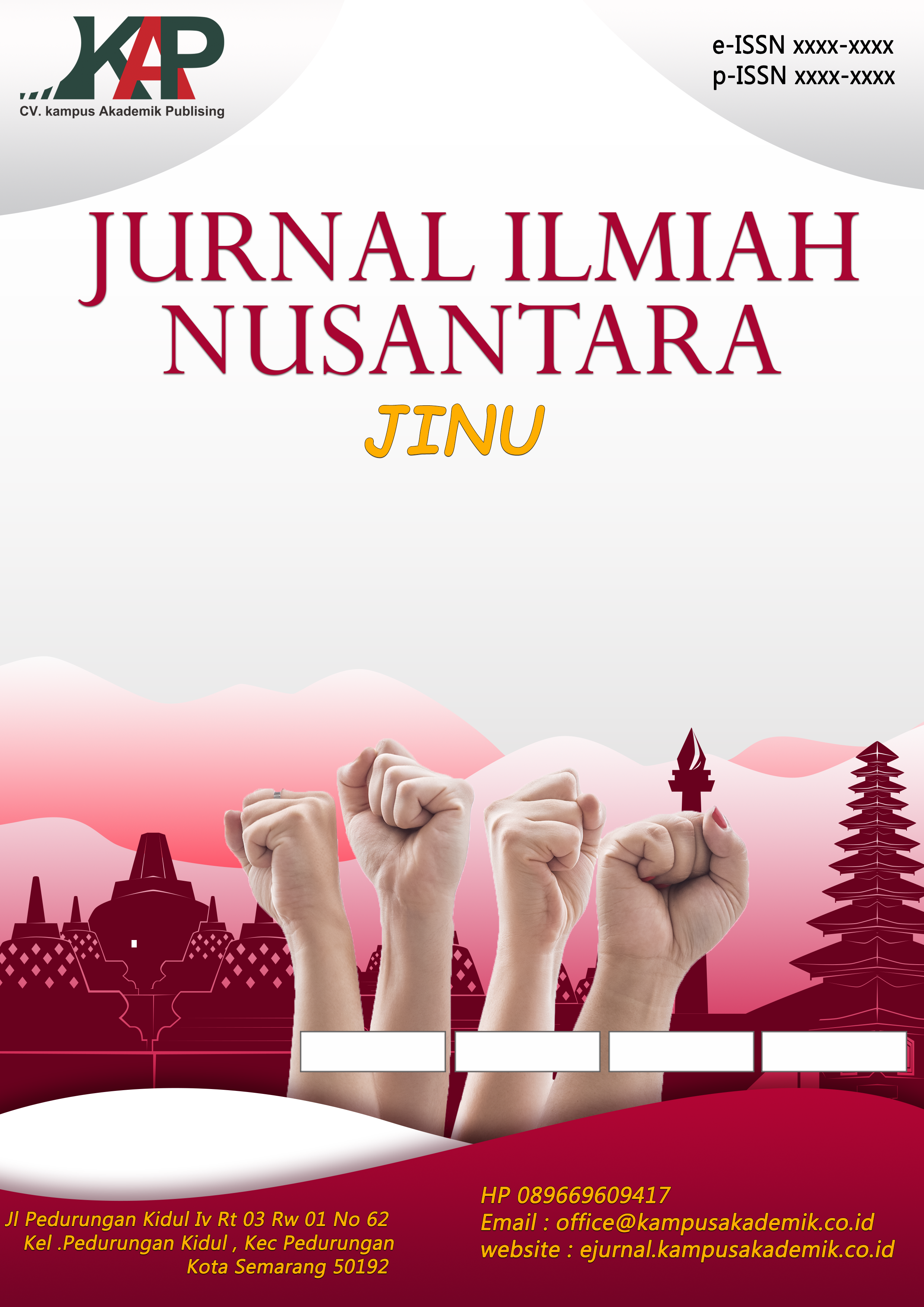Memahami Gaya Belajar Siswa: Kunci Keberhasilan Personalisasi Pembelajaran
DOI:
https://doi.org/10.61722/jinu.v2i1.3276Keywords:
Student Characteristics, Student Learning Style, Learning PersonalizationAbstract
This research discusses the importance of understanding students' learning styles as a key to personalizing education. Learning styles, which can be divided into three main categories: visual, auditory and kinesthetic, affect the way students absorb and understand information. Students with visual learning styles find it easier to understand material through vision, auditory students are more effective in learning through their hearing, while students with kinesthetic learning styles are more prominent in physical activities and hands-on interactions. This research emphasizes the need for educators to recognize and adapt teaching methods to students' learning preferences to improve engagement, motivation and academic outcomes. It also discusses the challenges in implementing personalized learning, such as the difficulty in identifying the right learning style and the risk of over-focusing on a particular learning style. The method in this research uses literature review by analyzing existing data regarding learning styles and their implications for personalized learning. Thus, this research is expected to provide insights for educators in designing teaching strategies that are more effective and responsive to students' individual needs
References
Ally, Mohamed. “Foundations of Educational Theory for Online Learning.” Theory and Practice of Online Learning 2, no. 1 (2004): 15–44.
Andriani, Feby, and Nursiwi Nugraheni. “Analisis Karakteristik Gaya Belajar Siswa Dalam Pembelajaran Berdiferensiasi.” Jurnal Riset Pendidikan Dasar (JRPD) 5, no. 1 (2024): 33. https://doi.org/10.30595/jrpd.v5i1.16067.
Bakar, M. Yunus Abu. “Pembentukan Karakter Lulusan Melalui Pembelajaran Bahasa Arab Di Pondok Modern Lirboyo Kediri.” Journal of Islamic Education Studies 1 (2016). http://repository.uinsa.ac.id/id/eprint/2059/2/M. Yunus Abu Bakar_jurnal_Pembentukan Karakter Lulusan.pdf.
Bakar, M Yunus Abu, Nur Kholis, and Siti Marpuah. “The Innovation of Islamic Education Learning Through Quantum Learning Model.” TADRIS: Jurnal Pendidikan Islam 18, no. 2 (2023): 66–81. https://doi.org/10.19105/tjpi.v18i2.10236.
Bice, Sara, Kieren Moffat, David Zilberman, Tim G. Holland, Itai Trilnick, José B. Falck-Zepeda, Priya Kurian, et al. “Model Personalized Learning.” Resources Policy 7, no. 1 (2017): 1–10. https://gain.fas.usda.gov/Recent GAIN Publications/Agricultural Biotechnology Annual_Ottawa_Canada_11-20-2018.pdf%0Ahttps://doi.org/10.1016/j.resourpol.2020.101869%0Ahttp://dx.doi.org/10.1016/j.jenvman.2017.06.039%0Ahttp://www.oecd.org/gov/regulatory-poli.
Christensen, C. “Disrupting Class: How Disruptive Innovation Will Change the Way the World Learns.” McGraw-Hill, 2008.
Creswell, John W. “Qualitative Inquiry and Research Design: Choosing among Five Traditions.” thousand oaks, ca: Sage London, 1998.
Darmuki, Agus & Ahmad Hariyadi. “Eksperimentasi Model Pembelajaran Jucama Ditinjau Dari Gaya Belajar Terhadap Prestasi Belajar Mahasiswa Mata Kuliah Berbicara Di Prodi Pbsi Ikip Pgri Bojonegoro” 3202 (2019).
Deri, Alco. “Personalisasi E-Learning Berbasis Model Gaya Belajar Felder-Silverman: Analisis Efektivitas Terhadap Hasil Belajar” 5 (2023): 1–14. https://www.ncbi.nlm.nih.gov/books/NBK558907/.
Dunn, Rita, and Kenneth J Dunn. Teaching Students through Their Individual Learning Styles: A Practical Approach. Reston, 1978.
Estari, Aan Whiti. “Pentingnya Memahami Karakteristik Peserta Didik Dalam Proses Pembelajaran” 3, no. 3 (2020).
Felder, Richard M, and Linda K Silverman. “Learning and Teaching Styles in Engineering Education.” Engineering Education 78, no. 7 (1988): 674–81.
Fleming, Neil D, and Colleen Mills. “Not Another Inventory, Rather a Catalyst for Reflection.” To Improve the Academy 11, no. 1 (1992): 137–55.
Friedman, Paul. “Book Reviews: GARDNER, H. (1983). Frames of Mind: The Theory of Multiple Intelligences. NYC: Basic Books; 440 Pp. $23.50.” Gifted Child Quarterly 29 (1985): 94–95. https://api.semanticscholar.org/CorpusID:143757363.
Gani, Arsyad Abd. “Interaksi Antara Pemanfaatan Media Pembelajaran Dan Gaya Belajar Terhadap Hasil Belajar IPS Terpadu” 6, no. 2 (2018).
Khovivah, Ananda &Weni Tria Anugrah Putri. “Profil Gaya Belajar Siswa Dan Faktor Yang Mempengaruhinya Di Kelas VA MIN 6 Ponorogo,” n.d., 318–33.
Kolb, David A. “Experiential Learning: Experience as the Source of Learning and Development.” Journal of Organizational Behavior 8 (1987): 359–60. https://api.semanticscholar.org/CorpusID:144884266.
Lestari, Hana Putri, Siska Putriani, and Imami Nur Rahmawati. “Kontribusi Gaya Belajar Terhadap Minat Belajar Siswa Selama Masa Pandemi Covid-19 Di Madrasah Ibtidaiyah Anwarul Hidayah.” JURNAL KAJIAN ISLAM MODERN, 2022. https://api.semanticscholar.org/CorpusID:258477643.
Marpaung, Junierissa. “Pengaruh Gaya Belajar Terhadap Prestasi Belajar Siswa.” KOPASTA: Jurnal Program Studi Bimbingan Konseling 2, no. 2 (2016): 13–17. https://doi.org/10.33373/kop.v2i2.302.
Meriyati. Memahami Karakteristik Anak Didik. Lampung: Fakta Press IAIN Raden Intan Lampung, 2015.
Munir, Nur Syamsinar, Hamsu Abdul Gani, and Abdul Muis Mappalotteng. “Pengaruh Media Pembelajaran E-Learning, Gaya Belajar, Dan Motivasi Belajar Terhadap Hasil Belajar Siswa Pada Mata Pelajaran Simulasi Dan Komunikasi Digital Kelas X Di Smk Negeri 2 Pinrang.” UNM Journal of Technology and Vocational, 2022. https://api.semanticscholar.org/CorpusID:265619326.
Pashler, Harold, Mark McDaniel, Doug Rohrer, and Robert Bjork. “Learning Styles: Concepts and Evidence.” Psychological Science in the Public Interest 9, no. 3 (2008): 105–19.
Prasetiyo, Rahayu, and Arsika Yunarta. “The Effect of Reward and Punishment on Learning Motivation in Physical Education Learning.” JOURNAL RESPECS (Research Physical Education and Sports) 5, no. 1 (2023): 109–14.
Reigeluth, Charles M. Instructional Design Theories and Models: An Overview of Their Current Status. Routledge, 1983.
Ritonga, Nilam Cahya, and Indah Fitriah Rahma. “Analisis Gaya Belajar VAK Pada Pembelajaran Daring Terhadap Minat Belajar Siswa.” Jurnal Analisa, 2021. https://api.semanticscholar.org/CorpusID:237848670.
Sari, Ariesta Kartika. “Analisis Karakteristik Gaya Belajar Vak ( Visual , Auditorial , Kinestetik ) Mahasiswa Pendidikan.” Jurnal Ilmiah Edutic 1, no. 1 (2014): 1–12.
Septianti, Nevi, and Rara Afiani. “Pentingnya Memahami Karakteristik Siswa Sekolah Dasar Di SDN Cikokol 2.” As-Sabiqun 2, no. 1 (2020): 7–17. https://doi.org/10.36088/assabiqun.v2i1.611.
Sidin, Sri Andriani. “The Application of Reward and Punishment in Teaching Adolescents.” In Ninth International Conference on Language and Arts (ICLA 2020), 251–55. Atlantis Press, 2021.
Sugianto, Akhmad, Mitha Suci Qomariah, and Annastya Nur Alisha. “Peran Guru Bimbingan Dan Konseling Dalam Analisis Profil Gaya Belajar Siswa Sebagai Need Assessment Pembelajaran Berdiferensiasi.” G-Couns: Jurnal Bimbingan Dan Konseling, 2023. https://api.semanticscholar.org/CorpusID:259630155.
Supit, Deisye, Melianti Melianti, Elizabeth Meiske Maythy Lasut, and Noldin Jerry Tumbel. “Gaya Belajar Visual, Auditori, Kinestetik Terhadap Hasil Belajar Siswa.” Journal on Education 5, no. 3 (2023): 6994–7003. https://doi.org/10.31004/joe.v5i3.1487.
Thompson, Kirk. “Cognitive and Analytical Psychology Howard Gardner .Frames of Mind: The Theory of Multiple Intelligences. New York, Basic Books, 1983.” The San Francisco Jung Institute Library Journal 5 (1985): 40–64. https://api.semanticscholar.org/CorpusID:147503598.
Yani, Dwi Rahma, Susriyati Muhanal, and Aynin Mashfufah. “Implementasi Assemen Diagnostic Untuk Menentukan Profil Gaya Belajar Siswa Dalam Pembelajaran Diferensiasi Di Sekolah Dasar.” Jurnal Inovasi Dan Teknologi Pendidikan, 2023. https://api.semanticscholar.org/CorpusID:271145461.
Zulqarnain, Muhammad & Ulum Fatmahanik. “Identifikasi Kemampuan Pemecahan Masalah Kontekstual Ditinjau Dari Gaya Belajar Siswa” 2, no. 3 (2022): 293–304.
Downloads
Published
Issue
Section
License
Copyright (c) 2024 JURNAL ILMIAH NUSANTARA

This work is licensed under a Creative Commons Attribution-ShareAlike 4.0 International License.













